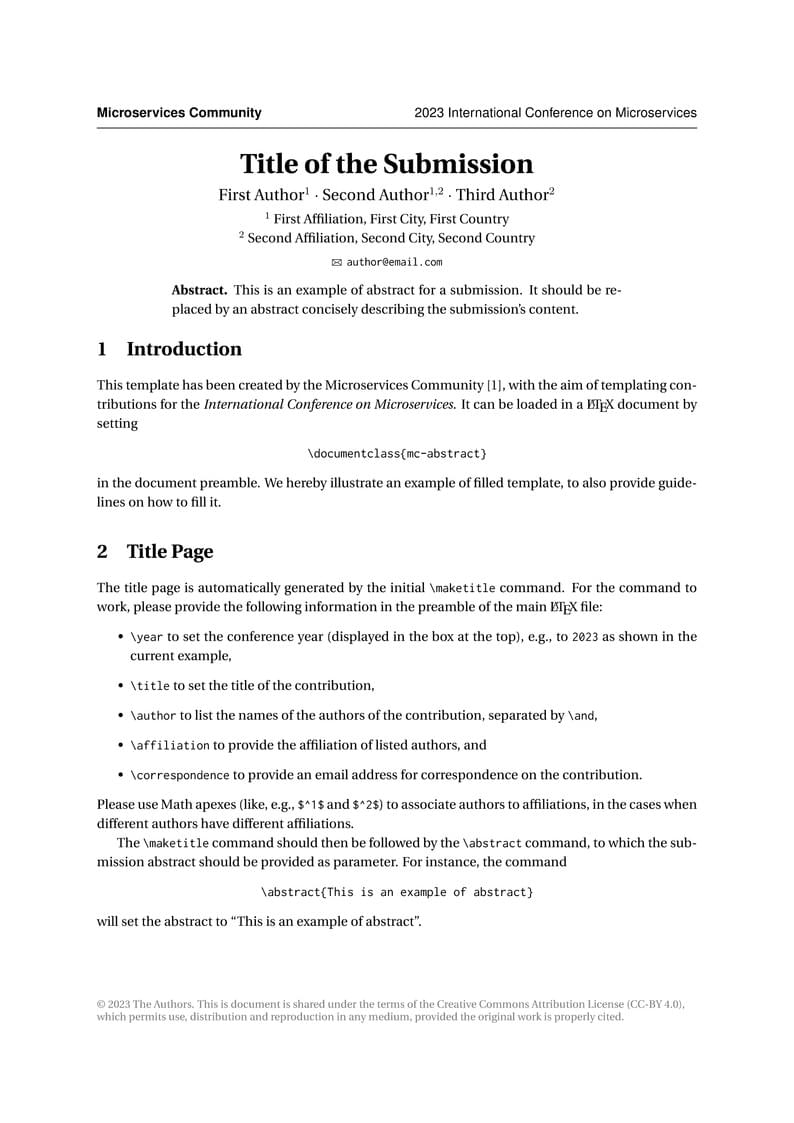
Template for preparing abstract for the Microservice Conference, organized by the Microservices Community

\documentclass{mc-abstract}
\year{2023}
\title{Title of the Submission}
\author{First Author$^1$ \and Second Author$^{1,2}$ \and Third Author$^2$}
\affiliation{
$^1$ First Affiliation, First City, First Country \\
$^2$ Second Affiliation, Second City, Second Country
}
\correspondence{author@email.com}
\begin{document}
\maketitle
\abstract{This is an example of abstract for a submission. It should be replaced by an abstract concisely describing the submission's content.}
\section{Introduction}
This template has been created by the Microservices Community \cite{MicroservicesCommunity}, with the aim of templating contributions for the \textit{International Conference on Microservices}.
It can be loaded in a \LaTeX{} document by setting
\begin{center}
\verb|\documentclass{mc-abstract}|
\end{center}
in the document preamble.
We hereby illustrate an example of filled template, to also provide guidelines on how to fill it.
\section{Title Page}
The title page is automatically generated by the initial \verb|\maketitle| command. For the command to work, please provide the following information in the preamble of the main \LaTeX{} file:
\begin{itemize}
\item \verb|\year| to set the conference year (displayed in the box at the top), e.g., to \verb|2023| as shown in the current example,
\item \verb|\title| to set the title of the contribution,
\item \verb|\author| to list the names of the authors of the contribution, separated by \verb|\and|,
\item \verb|\affiliation| to provide the affiliation of listed authors, and
\item \verb|\correspondence| to provide an email address for correspondence on the contribution.
\end{itemize}
Please use Math apexes (like, e.g., \verb|$^1$| and \verb|$^2$|) to associate authors to affiliations, in the cases when different authors have different affiliations.
The \verb|\maketitle| command should then be followed by the \verb|\abstract| command, to which the submission abstract should be provided as parameter. For instance, the command
\begin{center}
\verb|\abstract{This is an example of abstract}|
\end{center}
will set the abstract to \enquote{This is an example of abstract}.
\section{Using \LaTeX{} Environments}
\label{sec:examples}
This section illustrates how to use \LaTeX{} environments, from subsections and paragraphs, to figures, tables, and formulas.
\subsection{Examples of Figures and Tables}
This is an example of subsection, in which we provide examples of usage of \LaTeX{} environments.
Figures and tables can actually be included with the classical \texttt{figure} and \texttt{table} environments.
An example of figure is given in \Cref{fig:example}, whereas an example of table is given in \Cref{tab:example}.
\begin{figure}
\centering
\includegraphics[width=2cm]{fig.png}
\caption{Example of figure.}
\label{fig:example}
\end{figure}
\begin{table}
\centering
\begin{tabular}{|rccccc|}
\hline
& \textbf{1st column} & \textbf{2nd column} & \textbf{3rd column} & \textbf{4th column} & \textbf{5th column} \\
\hline
\textbf{1st Row} & Content & Content & Content & Content & Content \\
\textbf{2nd Row} & Content & Content & Content & Content & Content \\
\textbf{3rd Row} & Content & Content & Content & Content & Content \\
\hline
\end{tabular}
\caption{Example of table.}
\label{tab:example}
\end{table}
\subsection{Examples of Formulas}
This is another example of subsection, in which we provide examples of paragraphs with formulas.
\paragraph{Adding Formulas}
A formula can be added with classical \LaTeX{} \enquote{math} environments, like in the following quite popular example:
$$ e = mc^2 $$
Formulas can be even more complex, like using \texttt{array}s as shown hereafter:
\[
\left\langle
\begin{array}{ccc}
a & b & c \\ d & e & f \\ g & h & i
\end{array}
\right\rangle
\qquad
\left\uparrow
\begin{array}{ccc}
a & b & c \\
d & e & f \\
g & h & i
\end{array}
\right\}
\]
\section{Conclusions}
That's it. Please suitably fill the template and send your contribution to the upcoming edition of the \textit{International Conference on Microservices}! \Smiley
\bibliographystyle{plain}
\bibliography{biblio.bib}
\end{document}